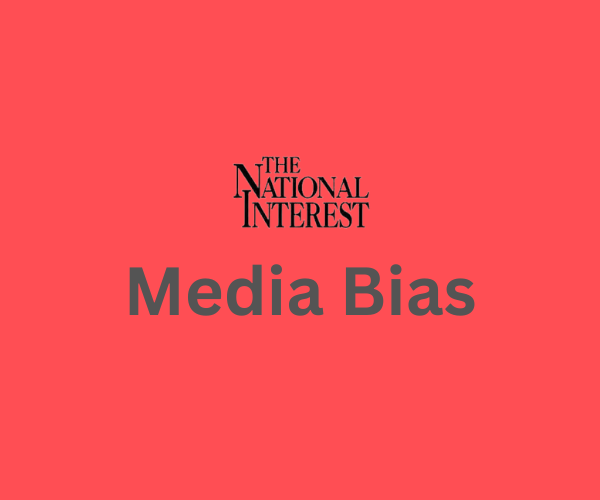
The National Interest is a US international affairs and American foreign policy publication founded in 1985 by American columnist and neoconservative advocate Irving Kristol. Billing itself as the foremost voice for what is known as “strategic realism,” the outlet prides itself on its hardnosed and levelheaded approach to foreign policy. The National Interest shifted to an online-only publication after the print edition shut down in 2023. According to the mission statement on their website, they take no particular ideological stance on the issues and provide only:
“… a vital stimulus towards fashioning a new foreign policy consensus based on civil and enlightened contention”.
They portray themselves as a nonpartisan outlet that “seeks to serve this country’s wider national interest.” We at Biasly believe that bold claims of impartiality deserve equally vigorous verification. We will analyze the publication’s coverage and editorial decisions to determine whether their reporting has discernible political bias. We hope to also shed light on the factors contributing to media bias and discuss how it operates.
How Does Biasly Rate News Sources?
Biasly’s algorithms produce bias ratings to help provide multiple perspectives on given articles. Biasly has analyzed 200,000+ news articles from more than 3,200 news sources through our A.I. technology and team of political analysts to find the most factual, unbiased news stories.
Biasly determines the degree of political bias in news sources by using Biasly’s Bias Meter Rating, in which Biasly’s team analyzes media sources’ reliability and bias and produces three scores, a Reliability Score that measures the accuracy of media sources; an A.I. Bias Score, evaluated by A.I.; and an Analyst Bias Score evaluated by political analysts. These scores are rated based on seven rating metrics including Tone, Tendency, Diction, Author Check, Selection/Omission, Expediency Bias, and Accuracy. These metrics help our analysts to determine the political attitude of the article.
Our A.I. machine-learning system employs natural language processing and entity-specific sentiment analysis to examine individual articles and determine their bias levels. By analyzing the key terms in an article such as policies, bias phrases, political terminologies, politicians, and their nicknames, the algorithms can rate the attitude of the text. Bias scores range from -100% and 100%, with higher negative scores being more liberal and higher positive scores being more conservative, and 0% being neutral.
Is The National Interest Politically Biased?
Biasly’s rating for The National Interest is based on two scores: one from its AI-based computer algorithms and the other from human Analysts. Biasly rated The National Interest with a Computer Bias Score of Center-Right and an Analyst Bias Score of Center-Right, which means that their coverage generally does an excellent job of avoiding a particular ideological slant. This conclusion was reached by averaging reviews of at least fifteen articles, each reviewed by one liberal, moderate, and conservative analyst. More accurate analyst scores are produced as more articles are rated, which enables us to hone in on a precise rating for the media source. The content on The National Interest generally lends credence to this rating, although there are some exceptions, which we will discuss further in the article.
Criticism of the bias in publications from the National Interest generally stems from its history. The New York Times, Politico, and others have commented on what they see as the journal’s conservative bias. As far back as 2005, the New York Times pointed to the journal’s origins, stating:
“For the decade since its founding by the neoconservative thinker Irving Kristol, The National Interest has been a central forum for the most influential conservative foreign policy thinkers of all stripes to hash out their differences.”
More recently, the Center for the National Interest, the public policy think tank that owns and operates The National Interest, hosted former president Donald Trump’s first foreign policy address back in 2016, to the dismay of some:
“The Center and its journal, the National Interest, are two of the most Kremlin-sympathetic institutions in the nation’s capital, even more so that the Carnegie Moscow Center, which has evolved from a hub of Russian liberalism into an accomodationist, intellectually-compromised think tank.”
Of course, opinions on the source will likely vary depending on the reader’s political leanings. Does the National Interest possess the bias its critics claim it does? Let us continue to investigate this question in greater depth. We will also provide the tools to identify bias and separate truth from fiction.
Before we begin, we need to discuss bias. Bias is a natural function of humans, and we can express it both consciously and unconsciously. Bias is one of the most fundamental forms of pattern recognition in humans. This isn’t to lower the bar and say that “all things are biased,” but to explain the process in which we may come to trust certain news organizations that display patterns of coverage.
On the media’s part, there is an incentive to retain audiences, encourage them to purchase subscriptions, and rate products positively. Bias is a two-way street; people want to see news stories about things they care about, and the media needs viewers to continue their operations. This creates a positive feedback loop that influences what stories are covered and from what perspective. This also explains the actions of more liberal news organizations.
Analysis of Bias in The National Interest Online Articles
To find out what kind of content the National Interest produces, we must first have a clear profile of their typical reader. Similarweb’s analytics tell us that the readership for the National Interest trends older and male; 76% of the audience is male, and almost 40% of that audience is over 55. This audience also typically reads similar international affairs and defense publications, including Foreign Policy, Foreign Affairs, RealClearWorld, and DefenseNews. Since the National Interest attracts such a particular audience, it becomes necessary to consider whether the tastes of this audience have a specific effect on their coverage.
To fulfill this task, we will use some of the most common metrics for determining bias: tone, diction, tendency, author bias, and expediency bias. Tone describes the particular attitude that the author takes in their writing. This directly relates to diction, which simply refers to the author’s choice of words. Tendency outlines the frequency with which the author assumes a distinct tone or slant in their work, which also relates directly to authorial bias or the bias that an author has historically shown in the past, whether in other articles they have written or in different sources like their social media presence. Finally, expediency bias reveals itself in the presentation elements within an individual article, such as the headline, images, or summary.
The first article we will analyze is “Border Crisis is no Accident. It’s Biden Making Good on Campaign Promises” by Tim Murtaugh. This piece presents itself as objective reporting but is contains conservative bias, as it denounces the Biden administration for what it deems “lax immigration enforcement.”The tone of the article makes itself immediately apparent, dripping with sarcasm as it begins:
“If you wanted to make up something to depict President Joe Biden as the cause of the border crisis, you might invent a scenario in which he was just turning illegal immigrants loose into the interior of the country. But you don’t have to imagine it because it’s reality, and it’s no accident.”
The tone of the article continues in a similar vein as the author bludgeons the reader with his opinions, mocking Biden’s “reckless” policy:
“If you were going to envision immigration policy that was exactly wrong, what Biden is doing would be it.”
As for diction, the article adopts a similarly extreme manner, calling an attempt by White House press secretary Jen Psaki to blame former President Donald Trump for the “massive increase in border crossings” as “ludicrous.” Murtaugh goes on to assert that Biden “campaigned for president promising an array of enticements for people to break our laws to enter this country,” essentially arguing that the administration is allowing this crisis to occur for their own personal benefit, and claims that the crisis is “certain and obvious”. This claim is strong but is supplied without clear evidence thus weakening the claim. To avoid bias, the author could provide further evidence.
“All of this is laid at the feet of Biden, whose administration infamously refused to call the scene at the border a “crisis,” even though it most certainly and obviously is one.”
As for the author’s tendencies, a closer look at his Twitter profile shows that Murtaugh is not shy about expressing his highly conservative views, reposting support for conservative candidates, and taking positions on issues unfavorable to the Biden administration. For example, take this repost from former Trump press secretary and communications director Sean Spicer.
Trump’s Front Row Joes
The first inside look at the people behind the greatest political movement in American history. Ordinary and extraordinary men and women who stand shoulder-to-shoulder with Trump as he seeks to make America great again@WatchSalemNews pic.twitter.com/UsN6fowayY
— Sean Spicer (@seanspicer) June 21, 2024
Or this repost from a pro-Trump account, where Murtaugh makes clear his anti-Biden sentiment:
First, they said Hunter Biden’s laptop was “Russian disinformation” when it pointed to Joe Biden’s involvement in the family cash grab schemes.
Now, any video that’s potentially embarrassing is a “deep fake.”
You can interpret the videos different ways, but fakes they are not. https://t.co/echCyYVIjm
— Tim Murtaugh (@TimMurtaugh) June 17, 2024
The article omits any information from sources that could paint a more neutral picture of the situation. Every source that the author selects paints administration officials as incompetent bumblers at best and bad actors at worst, as shown by the article title and by quotes chosen, such as:
“All of this puts the lie to Biden’s claims that this surge at the border is something that happens ‘every single, solitary year.’
One could argue that this article does not represent The National Interest’s overall coverage; in their defense, it is a repost from The Daily Signal. Still, the staff chose to republish this piece, and there is no disclaimer in the article that states that the piece is not representative of the opinions of The National Interests or its editors. Without this, we are forced to conclude that this article is presented as a piece of particularly conservative-biased reporting from The National Interest, which is (at first glance) at odds with our rating of the National Interest as an outlet with a relatively centrist outlook.
This shows that article bias frequently differs between individual articles and their authors, even those within the same organization. It is, therefore, paramount to be alert for any signs of bias- including tendency, diction, author, omission/selection, and expediency bias- in whatever media you might come across.
For an article more generally representative of the National Interest’s coverage, consider “Get Ready for the Future of Artificial Intelligence in the War Realm” by Kris Osborn, defense editor for the National Interest. The subject and tone of this article is much more neutral and fact-based than the previous example, careful to remove any potentially inflammatory wording and focusing entirely on reporting on an event- the development by the Defense Advanced Research Projects Agency (DARPA) of AI technology which will allow surveillance drones to identify potential and relevant targets quickly. The author’s tone is consistently neutral and noncommittal, focusing on reporting a development without any content that would display a political bias, and this is also reflected in his choice of words, as indicated by the frequent qualification of claims in the quotes below:
“Defense Advanced Research Projects Agency (DARPA) and several industry partners such as Raytheon Intelligence & Space, Northrop Grumman and BAE Systems are now fast-tracking a technological system engineered to find and transmit only images or pixels that have “changed” in order to pinpoint moments of relevance. This is critical, as a drone might have surveillance cameras on a specific static area looking for enemy movements or any key developments of interest for hours and hours. How can that seemingly unmanageable volume of data be organized efficiently to only transmit data of value to human decision-makers?”
“It would make sense that an advanced algorithm might have this ability, as AI-enabled programs are engineered to recognize and catalog patterns, find anomalies and discern new input.”
The author avoids omission and selection bias, having carefully chosen sources that focus on the provision of information, either explaining terms that may be unclear or providing statements that tout the goals or intent of the technology:
“A Raytheon statement, which quotes Brad Tousley, vice president for Advanced Concepts Technology at Raytheon Intelligence & Space, says the new technology helps identify moments of critical combat relevance to save time and expedite mission efficiency…. The technology would allow sensors to forego hours of data-intensive video streaming by reacting only when there is activity. The potential result is 100 times less data generated and 100 times less power used by the sensor compared to today’s IR sensors.”
An investigation of Kris Osborn’s background revealed that apart from his role as the Defense Editor for the National Interest, he is also President and Editor-in-Chief of the Center for Military Modernization, whose blog Warrior Maven focuses on military news and analysis with an emphasis on emerging technologies, subjects which dovetail perfectly with the topic of this article. Other publications by Mr. Osborn for The National Interest include “Lockheed Martin Makes Progress on Next-Generation Interceptor,” “Ukraine Shows the West How to Conduct Small Arms Maneuver,” and “JADC2: How the Army Is Making Data a Weapon of War”. Given Osborn’s experience as a Highly Qualified Expert with the Office of the Assistant Secretary of the Army- Acquisition, Logistics, and Technology, as well as his history of publications about military technology, we are inclined to believe he avoids political bias and is speaking purely as someone with the technical expertise and authority to do so.
This perception is enhanced by the article’s relative lack of expediency bias. The word choice for the title “Get Ready for the Future of Artificial Intelligence in the War Realm” conveys the author’s expertise and willingness to inform the reader, and possibly alert the reader to potentially feel fear with mixing AI with war. Such fear may entice the reader to click and read more.

Source: The National Interest
Analysis Of The National Interest Opinion Articles
Any discussion of opinion pieces needs to touch on the distinction between opinion and reporting. Reporting pieces are intended to be unbiased and factual. They tend to use primary sources, such as direct quotes from interview subjects or documents, to provide the reader with enough quality information for them to form their own opinion. Opinion articles, however, are outlets given to authors for them to express their personal views on various subjects. The National Interest generally provides fairly balanced coverage but also has many articles with a considerable amount of subjectivity, and readers should be aware that some opinion articles on The National Interest’s website are not designated as such.
The first article we will review is “Biden’s Withdrawal from Afghanistan Demonstrates True Leadership” by Paul R. Pillar. This opinion piece praises President Biden for his handling of the US Withdrawal from Afghanistan and attempts to justify the withdrawal’s wisdom against what the author perceives as a probable wave of criticism.
This article is less notable for its particular bias (although Biasly rates this piece as “Extremely Conservative”) than it is for its highly condescending tone; although this article is clearly in line with the kind of content that The National Interest promotes, the tone tends to paint Biden in an unusually favorable light. Though the writer is well-informed, supplying many reasons why Biden’s actions should be supported, the diction is dismissive:
“His political opponents will, of course, milk the issue for whatever political advantage they can get from it. One can almost hear already the cries of “who lost Afghanistan” in the 2022 and 2024 election campaigns”.
The diction is also needlessly adulatory, praising Biden as an “empathetic and caring man” who has “immersed himself” in the Afghanistan issue. The author seems to spend more time trying to head off Biden’s critics than anything else, settling for snide quips:
“Biden will be criticized, but he is exercising stronger leadership on Afghanistan than his predecessors ever did.”
Though the author is erudite and well-informed, the article needlessly congratulates Biden and does not engage with possible criticism.
The second opinion article is “Why Joe Biden Must Engage China” by Kishore Mabubani. Despite being rated “Moderately Conservative” by Biasly, this article’s tone paints a picture of Biden being put in a corner regarding the necessity to get tough on China as a way to head off political opponents and strengthen Biden’s position against Trump:
“Republicans will ‘pounce’ on Biden if he appears soft on China… If the Biden administration were to attempt a complete reboot of American strategy towards China, it could chart a new path, demonstrating public toughness and firmness”.
The article maps out a strategy for Biden to build a China policy in contrast with Trump’s. The diction bears this out, providing opportunities for Biden to appear “careful,” “shrewd,” and “calculating.” Mabubani’s sourcing adds to this anti-Trump narrative, asserting that the US farming lobby has “suffered grievously from Trump’s hamfisted trade wars.” Even if true, the author’s diction makes his anti-Trump bias too evident, using words like “hamfisted” to describe his policies and deeming them “a boon for China in many ways.”
In short, the diction and tone of this article demonstrate the author’s bias too heavily. Therefore, though the Biasly News Check Chrome Extension rates this article as “Moderately Conservative,” and the article’s focus on foreign policy strategies is in line with the content that The National Interest usually publishes, this article is an excellent example of why it is essential to know how to distinguish subjective writing from genuine reporting.
Looking at the sentiment within the article, we see a wide range of opinions, covering both sides of the political spectrum with positive and negative terminology for both Joe Biden and Donald Trump. Therefore, we feel more assured concluding that the article is representative of the National Interest’s Center bias- it does a good job avoiding the pitfall of ideological bias; even though the article is about an outline for President Biden’s China policy, it takes pains to outline the potential pitfalls of strategies he could choose and does not specifically praise Biden for any actions which he has already taken.
Who Owns The National Interest?
The National Interest was acquired in 2001 by the Center for the National Interest, a public policy think tank in Washington, D.C., founded by former President Richard Nixon in 1994. At that time, the Center’s President and CEO was Dimitri Simes, a Russian-American author, editor, and pundit who served as Nixon’s informal policy advisor and was personally appointed by him to head the Center.

Dimitri K. Simes, 2023. Source: Wikipedia
The Center’s current President is Paul J. Saunders, a longtime employee, nonprofit executive, and former State Department advisor.
How to Evaluate and Uncover Bias
It can often be difficult to tell if the news you watch is biased. If you have settled on a news channel, it’s usually because you trust the information you are gaining. Unfortunately, many trust the information they are hearing because it confirms what they already believe. This is referred to as “confirmation bias.” It is important to challenge your beliefs and get third-party verification that what you are hearing is the full story. This is why we recommend using Biasly to compare different news stories side-by-side using our bias ratings to figure out what both sides think of a political issue.
To reiterate everything we have discussed above, Biasly rates the National Interest as “Center-Right” because of its general commitment to covering issues that typically fall outside the political binary and because of its neutral, fact-based coverage. That said, readers should still use their best judgment when reading articles from this outlet and be aware of any potential bias in the articles it publishes, as some pieces are more subjective than others. To determine the bias levels within a piece, please use the metrics described in this article. Also, consider using Biasly’s News Bias and Reliability Checker.






















